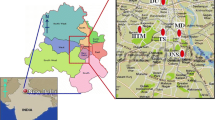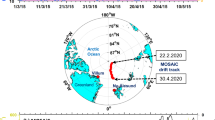Abstract
It is generally thought that phosphine (PH3) concentrations exist at the low ng/m3 level during the night and at the pg/m3 level during daylight in the remote atmosphere of the lower troposphere. The first determination of gaseous PH3 on the Antarctic Millor Peninsula is reported in this paper. No PH3 was detected in the air samples around 10:00 when it was sunny. However, PH3 was found in all the 10:00 air samples when it was cloudy or light snow with the average of 75.3±28.8 ng/m3 (n=5). It was also found in nearly all the samples around 22:00 with the average of 87.2±70.9 ng/m3 (n=11). Atmospheric PH3 concentrations around 22:00 were generally higher than those around 10:00 in January and they were almost the same in February. In addition, PH3 concentrations around 22:00 showed a downtrend with the decreasing air temperature, suggesting that light intensity and air temperature had an important effect on atmospheric PH3 concentration. It is very surprising to have found that high concentrations of PH3 exist in the Antarctic atmosphere under the influence of strong UV-radiation and light intensity. The tentative analyses show that dry, cold and very clean atmosphere may be very suitable for the PH3 survival and cause the concentration to increase and accumulate in the local atmosphere. New approaches for the PH3 formation and the process of atmospheric chemistry may exist under such an extreme environment. Atmospheric PH3 may also be from the emissions of local sources.
Similar content being viewed by others
References
Cao Y, Song Y, Sun G Y, et al. Review of toxicology on phosphine. J Zhengzhou Institute Technol (in Chinese), 2002, 23(2): 84–89
Han S H, Zhuang Y H, Zhang H X, et al. Phosphine and methane generation by the addition of organic compounds containing carbonphosphorus bonds into incubated soil. Chemosphere, 2002, 49: 651–657
Dévai I, Felfoldy L, Wintter I, et al. Detection of phosphine: new aspects of the phosphorus cycle in the hydrosphere. Nature, 1988, 333: 343–345
Yu Z M, Song X X. Matrix-bound phosphine: A new form of phosphorus found in sediment of Jiaozhou Bay. Chin Sci Bull, 2003, 48(1): 131–135
Gassmann G, Schorn F. Phosphine from harbor surface sediments. Naturwissenschaften, 1993, 80: 78–80
Roles J, Verstraete W. Biological formation of volatile phosphorus compounds. Bioresour Technol, 2001, 79: 243–250
Niu X J, Geng J J, Wang X R, et al. Temporal and spatial distributions of phosphine in Taihu Lake, China. Sci Total Environ, 2004, 323: 169–178
Han S H, Zhang Y H, Liu J A, et al. Phosphorus cycling through phosphine in paddy field. Sci Total Environ, 2000, 258: 195–203
Cao H F, Liu J A, Zhuang Y H, et al. Emission sources of atmospheric phosphine and simulation of phosphine formation. Sci China Ser B-Chem, 2000, 43(2): 162–168
Ding L L, Wang X R, Zhu Y X, et al. Effect of pH on phosphine production and the fate of phosphorus during anaerobic process with granular sludge. Chemosphere, 2005, 59(1): 49–54
Glindemann D, Bergmann A, Stottmeister, et al. Phosphine in the lower terrestrial troposphere. Naturwissenschaften, 1996, 83: 131–133
Glindemann D, Edwardsa M, Kuschkc P. Phosphine gas in the upper troposphere. Atmos Environ, 2003, 37: 2429–2433
Liu J A, Cao H F, Zhuang Y H, et al. Phosphine in the urban air of Beijing and its possible Sources. Water Air Soil Pollut, 1999, 116: 597–604
Liu X D, Sun L G, Xie Z Q, et al. Geochemical evidence for the influence of historical sea bird activities on Mochou lake sediments in the Zhongshan Station area, East Antarctica. Chin J Polar Res (in Chinese), 2004, 16(4): 295–309
Zhu R B, Sun L G, Kong D M, et al. Matrix-bound phosphine in Antarctic biosphere. Chemosphere, 2006, 64: 1429–1435
Glindemann D, Bergmann A. Spontaneous emission of phosphine from animal slurry treatment processing. Zent bl Hyg Umweltmed, 198(1): 49–56
Gassmann G, Van Beusekom J E E, Glindemann D. Offshore atmospheric phosphine. Naturwissenschaften, 1996, 83(3): 129–131
Sun L G, Xie Z Q, Zhao J L. The sediments of lake on the Ardley Island, Antarctica: Identification of penguin-dropping soil. Chin J Polar Res, 2001, 12(1): 1–8
Sun L G, Xie Z Q, Zhao J L, et al. Monitoring the concentration of N2O in the Fildes Peninsula, Maritime Antarctica. Chin Sci Bull, 2000, 45(21): 2000–2004
Sun L G, Zhu R B, Xie Z Q, Xing G X. Emissions of nitrous oxide and methane from Antarctic tundra: role of penguin dropping deposition. Atmos Environ, 2002, 36: 4977–4982
Author information
Authors and Affiliations
Corresponding author
Additional information
Supported by the National Natural Science Foundation of China (Grant Nos. 40676005 and 40406001), AAD Science Project 2873 and the Opening Foundation of State Key Laboratory of Soil and Sustainable Agriculture
About this article
Cite this article
Zhu, R., Kong, D., Sun, L. et al. The first determination of atmospheric phosphine in Antarctica. CHINESE SCI BULL 52, 131–135 (2007). https://doi.org/10.1007/s11434-007-0010-x
Received:
Accepted:
Issue Date:
DOI: https://doi.org/10.1007/s11434-007-0010-x




